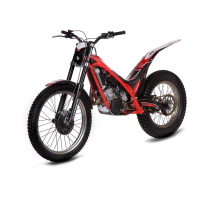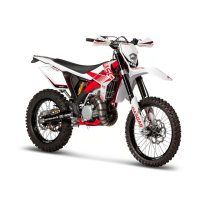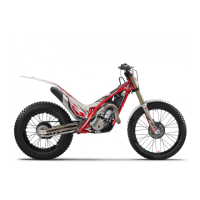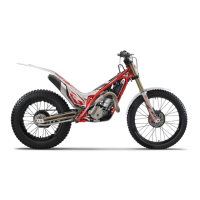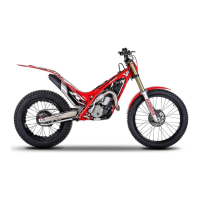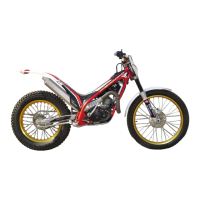
Do you have a question about the GAS GAS TXT PRO - 2008 and is the answer not in the manual?
| Transmission | 6-speed |
|---|---|
| Cooling System | Liquid cooled |
| Engine Type | Single cylinder, 2-stroke |
| Clutch | Wet, multi-disc |
| Front Suspension | Telescopic fork |
| Rear Suspension | Monoshock |
| Front Brake | Hydraulic disc |
| Rear Brake | Hydraulic disc |
Covers critical warnings, precautionary measures, and general notes for safe operation.
Details the warranty terms provided by GASGAS Motos, S.A. for the vehicle.
Defines the warranty duration, start date, and procedures for making claims.
Outlines purchaser responsibilities and items not covered by the warranty.
Explains various conditions, decisions on repairs, and rights regarding warranty claims.
Provides guidance on engine break-in, warming up, and recommended oil types and mixture.
Details engine size, bore, stroke, lubrication, and ignition systems.
Covers transmission type, gear ratios, frame material, and suspension details.
Provides specifications for brakes, overall dimensions, wheelbase, and fuel tank capacity.
Diagrams and labels identifying major external parts of the motorcycle.
Diagrams and labels identifying controls and upper vehicle components.
Presents a table detailing parts, check intervals, adjustments, and replacement schedules.
Explains how to locate and record the vehicle's serial and frame numbers.
Details the homologation plate information and key identification numbers.
Describes the location and operation of controls on the handlebar, including lights and indicators.
Instructions for locking the steering and warnings related to the ignition key.
Specifies fuel tank capacity and recommended gasoline octane rating.
Details the procedure for operating the quick-release fuel tank cap.
Explains the function and positions of the fuel tap, including the reserve.
Describes the choke operation for cold starts and adjusting the idle/mixture.
Guides on adjusting the free play in clutch and front brake levers.
Shows the correct position for the kick-start lever when not in use.
Details how to check and add engine oil, including capacity and oil type.
Explains the procedure for draining engine oil from the crankcase.
Provides instructions for checking, cleaning, and lubricating the air filter.
Step-by-step guide on how to remove the fuel tank for servicing.
Instructions for filling the radiator with coolant and safety precautions.
Details how to inspect spark plug condition and set the correct gap.
Procedure for removing the air filter box to gain access to the carburetor.
How to check the fuel level within the carburetor float bowl.
Instructions for thorough cleaning of the carburetor and its main nozzle.
Guidance on inspecting the reed box and the required distance between reeds and keeper.
Procedures for checking clutch stack height and clutch disc wear.
Details adjusting front suspension extension, compression, and bleeding air.
How to adjust the preload on the front suspension damper spring.
Instructions for cleaning, checking, and lubricating rear suspension linkages.
Guidance on inspecting the condition of swingarm bearings and holders.
Specific points for lubricating brake/clutch levers, gear shift, rear brake pedal, and footrests.
Details lubrication for engine starting lever, secondary chain, and handlebar controls.
Guidance on lubricating the chain tensor spring and gas control cable.
How to adjust chain slack and center the rear wheel using eccentric adjusters.
Correct positioning of the chain linkage relative to wheel travel.
Importance of checking tyre condition for optimal road adherence.
Recommended tyre pressures for normal and competition use.
Procedure for checking front and rear brake pad wear.
How to check front brake fluid level and bleed the brake circuit.
Instructions for checking the rear brake fluid reservoir level.
Steps to prepare the motorcycle for long-term storage to prevent damage.
Advice on washing the motorcycle to protect plastic parts and decals.
Overview of the multifunction display panel, its buttons, and indicators.
Explanation of the various symbols and icons shown on the display.
Detailed explanations of the various functions displayed, including tachometer, speedometer, and counters.
How to use the MODE and RESET buttons for navigation and data management.
Steps to configure the gear change indicator based on RPM.
Guide to configuring clock format, gear indicator, and wheel circumference.
Key advice on pre-ride checks, maintenance, and safe riding practices.
Legal information regarding technical modifications and liability.
Lists the required homologation components for road travel and inspections.


